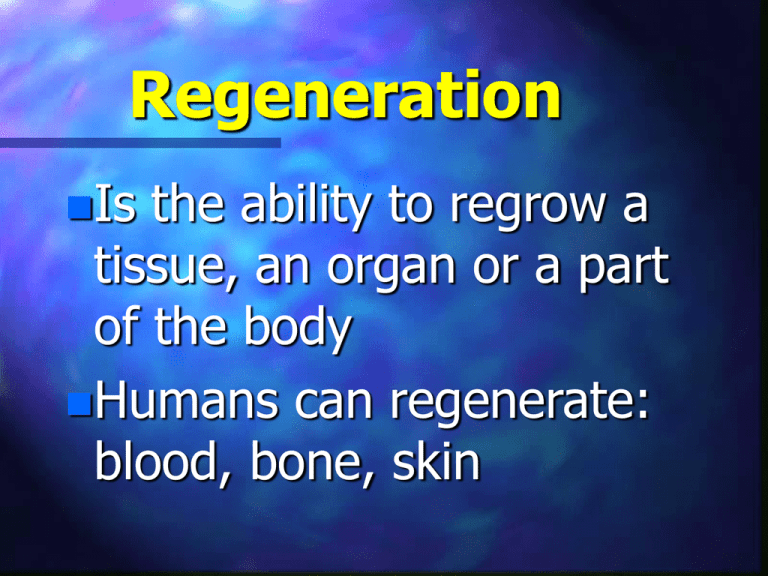why is regeneration important for some organisms Regeneration tissue electrospinning
Regeneration is a fascinating process that occurs in various organisms, allowing them to replace lost or damaged body parts. It is a captivating aspect of biology that showcases the remarkable abilities of living organisms to heal themselves. Let’s delve into the world of regeneration and explore how different organisms accomplish this incredible feat.
Regeneration: A Marvel of Nature
One image that comes to mind when we think of regeneration is that of a starfish. If you cut off one of its arms, it has the remarkable ability to grow a completely new arm in its place. This ability is not limited to just starfish; many creatures, from simple organisms like planarians to complex animals like salamanders, possess the ability to regenerate lost body parts.
 One of the most incredible aspects of regeneration is that it involves the regeneration of not just the outer tissue but also the different cell types that make up the missing body part. In the case of starfish, a group of cells at the site of the injury called the blastema provides the foundation for the regrowth process.
One of the most incredible aspects of regeneration is that it involves the regeneration of not just the outer tissue but also the different cell types that make up the missing body part. In the case of starfish, a group of cells at the site of the injury called the blastema provides the foundation for the regrowth process.
The process of regeneration typically begins with the formation of a blastema, which contains a population of undifferentiated cells capable of becoming specialized cells required for tissue repair. This enables the organism to not only replace lost parts but also restore their functionality.
Regeneration in Humans: A Closer Look
While humans have limited regenerative abilities compared to some animals, certain tissues in our bodies have the capacity to regenerate. One such example is the liver. The liver has the remarkable ability to regenerate itself following surgical removal or injury. This regenerative capacity is due to the presence of specialized cells called hepatocytes that can divide and replace damaged cells.
 Another example of limited regeneration in humans is the regeneration of skin. When we get a cut or a scrape, our body initiates a healing process that involves the formation of a scab, underneath which new skin cells are generated to close the wound. However, the regenerative capacity of the skin is limited, and in cases of severe burns or deep wounds, scar tissue may form instead of regenerated skin.
Another example of limited regeneration in humans is the regeneration of skin. When we get a cut or a scrape, our body initiates a healing process that involves the formation of a scab, underneath which new skin cells are generated to close the wound. However, the regenerative capacity of the skin is limited, and in cases of severe burns or deep wounds, scar tissue may form instead of regenerated skin.
Unraveling the Mysteries of Regeneration
Scientists are still unraveling the mysteries of regeneration and exploring the underlying mechanisms that drive this remarkable process. By studying organisms that exhibit robust regenerative abilities, researchers aim to uncover the cellular and molecular processes responsible for tissue repair and regeneration.
Understanding the mechanisms of regeneration holds immense promise for medical applications. It could potentially help in the development of therapies for conditions such as spinal cord injuries, heart diseases, and even organ transplantation.
Regeneration is truly a marvel of nature. It reminds us of the incredible abilities that living organisms possess. From starfish regrowing their arms to humans healing their wounds, the power of regeneration showcases the adaptability and resilience of life itself.
If you are looking for Explain regeneration - Science - How do Organisms Reproduce - 12389561 you’ve visit to the right web. We have 5 Pics about Explain regeneration - Science - How do Organisms Reproduce - 12389561 like Tissue Regeneration: Why are Electrospinning Devices Essential for, 1.3 Regeneration.ppt and also Tissue Regeneration: Why are Electrospinning Devices Essential for. Here it is:
Explain Regeneration - Science - How Do Organisms Reproduce - 12389561
 www.meritnation.comregeneration explain hydra reproduction organisms asexual
www.meritnation.comregeneration explain hydra reproduction organisms asexual
Why Cant Humans Reproduce Through Fragmentation And Regeneration
 www.meritnation.comwhy organisms regeneration reproduce cant humans fragmentation through multicellular
www.meritnation.comwhy organisms regeneration reproduce cant humans fragmentation through multicellular
Tissue Regeneration: Why Are Electrospinning Devices Essential For
 www.hiboox.comregeneration tissue electrospinning
www.hiboox.comregeneration tissue electrospinning
Research | The Harris Lab
 web.asu.eduregeneration harris
web.asu.eduregeneration harris
1.3 Regeneration.ppt
 studylib.netregeneration ppt regenerate
studylib.netregeneration ppt regenerate
1.3 regeneration.ppt. Why cant humans reproduce through fragmentation and regeneration. Explain regeneration